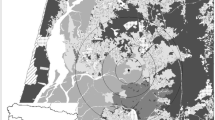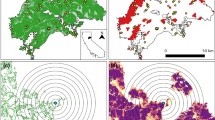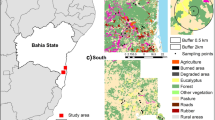Abstract
We investigated patterns of community structure (species composition, foraging activity, and nightly foraging patterns) of bats in relation to gradients of environmental variation in a tropical urban area. A total of 32 sites spread equally across eight habitat types were sampled in the city of Townsville, North Queensland, Australia. Each site was sampled on 3 non-consecutive occasions using automated AnaBat systems. Eleven species were confidently identified while a possible four more were identified only to the genus level. Ordination of environmental variables measured at these sites identified two distinct environmental gradients reflecting the degree of urbanisation and foliage density. With increasing urbanisation there was a decline in species richness and total foraging activity. We used regression trees to characterise foraging preferences of each species. This analysis suggested that only one species of Mormopterus was able to exploit the resources provided by urbanisation. This species foraged in areas with higher numbers of white streetlights. The remaining species of bats preferred to forage within close proximity to natural vegetation and with low numbers of streetlights. The density of vegetation in long-established suburbs did not substantially reverse the trend for urban areas to have fewer bat species than original habitats.
Similar content being viewed by others
References
Adams M, Reardon TR, Baverstock PR, Watts CHS (1988) Electrophoretic resolution of species boundaries in Australian Microchiroptera IV. The Molossidae (Chiroptera). Aust J Biol Sci 41:315–326
Blake D, Hutson AM, Racey PA, Rydell J, Speakman JR (1994) Use of lamp lit roads by foraging bats in southern England. J Zool (Lond) 234:453–462
Bredt A, Uieda W (1996) Bats from the urban and rural environments of the Distrito Federal, mid-western Brazil. Chiroptera Neotropical 2:54–57
Brosset A, Charles-Dominique P, Cockle A, Cosson J, Masson D (1996) Bat communities and deforestation in French Guiana. Can J Zool 74:1974–1982
Churchill S (1998) Australian bats. Reed New Holland Publishers, Sydney, Australia
Crome FHJ, Richards GC (1988) Bats and gaps: Microchiropteran community structure in a Queensland rainforest. Ecology 69:1960–1969
De’ath G, Fabricius KE (2000) Classification and regression trees: A powerful yet simple technique for ecological data analysis. Ecology 81:3178–3192
de Oliveira M (1998) AnaBat System Practical Guide: Survey techniques, collection and characterization of reference bat echolocation calls, common field problems and problem solving. Department of Natural Resources, Brisbane, Australia
Fenton MB (1982) Echolocation calls and patterns of hunting and habitat use of bats (Microchiroptera) from Chillagoe, North Queensland. Aust J Zool 30:417–425
Fenton MB (1990) The foraging behaviour and ecology of animal-eating bats. Can J Zool 68:411–422
Fenton MB (1997) Science and the conservation of bats. J Mammal 78:1–14
Fenton MB, Boyle NG, Harrison TM, Oxley DJ (1977) Activity patterns, habitat use and prey selection by some African insectivorous bats. Biotropica 9:73–85
Fullard JH, Koehler C, Surlykke A, McKenzie NL (1991) Echolocation ecology and flight morphology of insectivorous bats (Chiroptera) in south-western Australia. Aust J Zool 39:427–438
Gaisler J, Bauerova Z (1985–1986) The life of bats in a city. Myotis 23–24:209–215
Gaisler J, Zukal J, Rehak Z, Homolka M (1998) Habitat preference and flight activity of bats in a city. J Zool (Lond) 244:439–445
Geggie J, Fenton MB (1985) A comparison of foraging by Eptesicus fuscus (Chiroptera: Vespertilionidae) in urban and rural environments. Can J Zool 63:263–267
Hall LS, Richards GC (1985) The bats of Chillagoe. Tower Karst 5:13–22
Hayes JP (1997) Temporal variation in activity of bats and the design of echolocation monitoring studies. J Mammal 78:514–524
Hayes JP (2000) Assumptions and practical considerations in the design and interpretation of echolocation monitoring studies. Acta Chiropterol 2:225–236
Jones G, Corben C (1993) Echolocation calls from six species of microchiropteran bats in south-eastern Queensland. Aust Mammal 16:35–38
Jones KE, Altringham JD, Deaton R (1996) Distribution and population densities of seven species of bat in northern England. J Zool 240:788–798
Jones G, Jayne AF (1991) Bats in Avon: their distribution in relation to the urban environment. Proc Brist Nat Soc 48:31–51
Jones G, Rydell J (1994) Foraging strategies and predation risk as factors influencing emergence time in echolocating bats. Philos Trans R Soc Lond Biol Sci 346:445–455
Kalko EKV (1998) Organization and diversity of tropical bat communities through space and time. Zoology 101:281–297
Kitchener DJ, Cooper N, Maryanto L (1995) The Myotis adversus (Chiroptera: Vespertilionidae) species complex in Eastern Indonesia, Australia, Papua New Guinea and the Soloman Islands. Rec W Aust Mus 17:191–212
Kirsten I, Klomp NI (1998) Microchiroptera in urban, rural and forest areas of southern NSW. Australas Bat Soc Newsl 11:28–30
Kunz TH (1973) Resource utilization: temporal and spatial components of bat activity in Central Iowa. J Mammal 54:14–32
Kurta A, Teramino JA (1992) Bat community structure in an urban park. Ecography 15:257–261
Lavery HJ, Johnson PM (1968) Mammals and birds of the Townsville district, North Queensland. 1. Introduction and mammals. Qld J Agric Anim Sci 25:29–37
Law B, Anderson J, Chidel M (1998) A bat survey in the state forests on the southwest slopes region of New South Wales with suggestions of improvements for future surveys. Aust Zool 30:467–479
Legakis A, Papadimitriou C, Gaethlich M, Lazaris D (2000) Survey of the bats of the Athens metropolitan area. Myotis 38:41–46
Lesinski G, Fuszara E, Kowalski M (2000) Foraging areas and relative density of bats (Chiroptera) in differently human transformed landscapes. Z Säugetierkd 65:129–137
Ludwig JA, Reynolds JF (1988) Nonlinear Ordination. In: Ludwig JA, Reynolds JF (eds), Statistical ecology: A primer on methods and computing. Wiley, New York, USA, pp. 257–273
Mackenroth T (2000) The Townsville/Thuringowa Strategy Plan. Queensland Department of Communication and Information, Local Government, Planning and Sport. Australia
McDonald JT, Rautenbach IL, Nel JAJ (1990) Foraging ecology of bats observed at De Hoop provincial nature reserve, southern Cape Province. S Afr J Wildl Res 20:33–145
Norberg U (1987) Wing form and flight mode in bats. In: Fenton MB, Racey P, Rayner J (eds), Recent Advances in the Study of Bats, volume 316 Cambridge University Press, Cambridge. pp. 335–427
Norberg U, Rayner J (1987) Ecological morphology and flight in bats. Philos Trans R Soc Lond Biol Sci 316:335–427
O’Farrell MJ, Miller BW, Gannon WL (1999) Qualitative identification of free flying bats using the AnaBat detector. J Mammal 80:11–23
Reardon T (1999) Nomenclature of Tadarida australis (Gray 1838). Australas Bat Soc Newsl 12:22–24
Richards G (1989) Nocturnal activity of insectivorous bats in relative to temperature and prey availability in tropical Queensland. Aust Wildl Res 16:151–158
Robson S (1984) Myotis adversus (Chiroptera: Vespertilionidae): Australia’s fish-eating bat. Aust Mammal 7:51–59
Rydell J (1992) Exploitation of insects around streetlamps by bats in Sweden. Funct Ecol 6:744–750
Rydell J, Bushby A, Cosgrove C, Racey PA (1994) Habitat use by bats along rivers in NE Scotland. Folia Zool 43:417–424
Rydell J, Entwistle A, Racey PA (1996) Timing of foraging flights of three species of bats in relation to insect activity and predation risk. Oikos 76:243–252
Rydell J, Racey PA (1995) Streetlamps and the feeding ecology of insectivorous bats. Symp Zool Soc Lond 67:291–307
Safi K, Kerth G (2004) A comparative analysis of specialisation and extinction risk in temperate zone bats. Conserv Biol 18:1293–1303
Savard JL, Clergeau P, Mennechez G (2000) Biodiversity concepts and urban ecosystems. Landsc Urb Plan 48:131–142
Taylor RJ, O’Neill MG (1988) Summer activity patterns of insectivorous bats and their prey in Tasmania. Aust Wildl Res 15:533–539
Van Der Ree R, McCarthy MA (2005) Inferring persistence of indigenous mammals in response to urbanisation. Anim Conserv 8:309–319
Vaughan N, Jones G, Harris S (1997) Habitat use by bats (Chiroptera) assessed by means of a broadband acoustic method. J Appl Ecol 34:716–730
Walsh AL, Harris S, Hutson AM (1995) Abundance and habitat selection of foraging vespertilionid bats in Britain: a landscape scale approach. Symp Zool Soc Lond 67:325–344
Walsh AL, Harris S (1996) Foraging habitat preferences of vespertilionid bats in Britain. J Appl Ecol 33: 508–518
Williams SE, Pearson RG, Walsh PJ (1996) Distributions and biodiversity of the terrestrial vertebrates of Australia’s wet tropics: A review of current knowledge. Pac Conserv Biol 2:327–362
Zar JH (1999) Biostatistical Analysis,4th edn. Prentice-Hall of Australia Pty. Limited, Sydney, Australia
Author information
Authors and Affiliations
Corresponding author
Rights and permissions
About this article
Cite this article
Hourigan, C.L., Johnson, C. & Robson, S.K.A. The structure of a micro-bat community in relation to gradients of environmental variation in a tropical urban area. Urban Ecosyst 9, 67–82 (2006). https://doi.org/10.1007/s11252-006-7902-4
Published:
Issue Date:
DOI: https://doi.org/10.1007/s11252-006-7902-4




